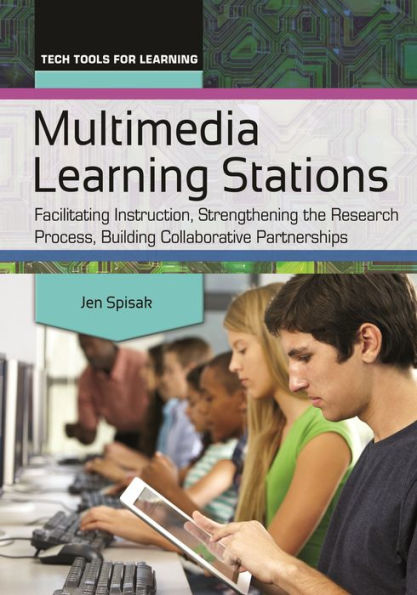Multimedia Learning Stations: Facilitating Instruction, Strengthening the Research Process, Building Collaborative Partnerships
Learn how to use rotating multimedia learning stations, employing databases, websites, education apps, videos, audio podcasts, online games, books, and more to build a strong, collaborative library program that helps you strengthen student understanding of the research process.
Libraries across America are losing funding and suffering from cuts in positions and programs. The process presented here will help you increase library use and prove that school libraries—and librarians—are a necessity. Written for middle and secondary school librarians, the book provides a guide to using standards-based and content-focused learning stations in the library to facilitate instruction and strengthen students' research skills. You'll learn what multimedia stations are, why they should be used, and how to use them to enhance and extend direct instruction. Plus, the book breaks down the steps for building sets of stations and shows you how to organize and implement them for maximum impact.
In addition to describing the "hows," the book provides sound arguments for why multimedia learning stations work. The method ensures that students gain continued practice with resources and build the skills and dispositions you want them to have. It also increases the amount of collaboration you'll have with teachers and enhances your interactions with and influence on your students. Teacher and student testimonials are interspersed throughout the book, and appendices offer you specific examples from which to draw.
1120790515
Libraries across America are losing funding and suffering from cuts in positions and programs. The process presented here will help you increase library use and prove that school libraries—and librarians—are a necessity. Written for middle and secondary school librarians, the book provides a guide to using standards-based and content-focused learning stations in the library to facilitate instruction and strengthen students' research skills. You'll learn what multimedia stations are, why they should be used, and how to use them to enhance and extend direct instruction. Plus, the book breaks down the steps for building sets of stations and shows you how to organize and implement them for maximum impact.
In addition to describing the "hows," the book provides sound arguments for why multimedia learning stations work. The method ensures that students gain continued practice with resources and build the skills and dispositions you want them to have. It also increases the amount of collaboration you'll have with teachers and enhances your interactions with and influence on your students. Teacher and student testimonials are interspersed throughout the book, and appendices offer you specific examples from which to draw.
Multimedia Learning Stations: Facilitating Instruction, Strengthening the Research Process, Building Collaborative Partnerships
Learn how to use rotating multimedia learning stations, employing databases, websites, education apps, videos, audio podcasts, online games, books, and more to build a strong, collaborative library program that helps you strengthen student understanding of the research process.
Libraries across America are losing funding and suffering from cuts in positions and programs. The process presented here will help you increase library use and prove that school libraries—and librarians—are a necessity. Written for middle and secondary school librarians, the book provides a guide to using standards-based and content-focused learning stations in the library to facilitate instruction and strengthen students' research skills. You'll learn what multimedia stations are, why they should be used, and how to use them to enhance and extend direct instruction. Plus, the book breaks down the steps for building sets of stations and shows you how to organize and implement them for maximum impact.
In addition to describing the "hows," the book provides sound arguments for why multimedia learning stations work. The method ensures that students gain continued practice with resources and build the skills and dispositions you want them to have. It also increases the amount of collaboration you'll have with teachers and enhances your interactions with and influence on your students. Teacher and student testimonials are interspersed throughout the book, and appendices offer you specific examples from which to draw.
Libraries across America are losing funding and suffering from cuts in positions and programs. The process presented here will help you increase library use and prove that school libraries—and librarians—are a necessity. Written for middle and secondary school librarians, the book provides a guide to using standards-based and content-focused learning stations in the library to facilitate instruction and strengthen students' research skills. You'll learn what multimedia stations are, why they should be used, and how to use them to enhance and extend direct instruction. Plus, the book breaks down the steps for building sets of stations and shows you how to organize and implement them for maximum impact.
In addition to describing the "hows," the book provides sound arguments for why multimedia learning stations work. The method ensures that students gain continued practice with resources and build the skills and dispositions you want them to have. It also increases the amount of collaboration you'll have with teachers and enhances your interactions with and influence on your students. Teacher and student testimonials are interspersed throughout the book, and appendices offer you specific examples from which to draw.
50.0
In Stock
5
1

Multimedia Learning Stations: Facilitating Instruction, Strengthening the Research Process, Building Collaborative Partnerships
240
Multimedia Learning Stations: Facilitating Instruction, Strengthening the Research Process, Building Collaborative Partnerships
240
50.0
In Stock

Product Details
| ISBN-13: | 9781440835179 |
|---|---|
| Publisher: | Bloomsbury Academic |
| Publication date: | 09/28/2015 |
| Series: | Tech Tools for Learning |
| Pages: | 240 |
| Product dimensions: | 8.40(w) x 10.80(h) x 0.60(d) |
About the Author
From the B&N Reads Blog
